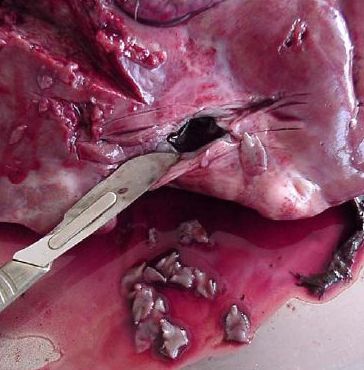-
 Band theory
Band theory
-
 Opportunistic species
Opportunistic species
-
 ELT
ELT
-
 Diurnal
Diurnal
-
 Polypyrrole
Polypyrrole
-
 Regional Natural Park
Regional Natural Park
-
 Gestagen
Gestagen
-
 Amphibolite
Amphibolite
-
 Access control
Access control
-
 Grid computing
Grid computing
-
 Sensitive Natural Space
Sensitive Natural Space
-
 Chrysalis
Chrysalis
-
 Wind turbine
Wind turbine
-
 Monoculture
Monoculture
-
 Hadron
Hadron
-
 Androgen
Androgen
-
 Main distribution frame
Main distribution frame
-
 Cortisone
Cortisone
-
 Klein bottle
Klein bottle
-
 Narcotic
Narcotic
-
 Ordovician
Ordovician
-
 Black-veined white
Black-veined white
-
 Log in
Log in
-
 Paleomagnetism
Paleomagnetism
-
 Plutonic
Plutonic
-
 Marburg fever
Marburg fever
-
 Febrile
Febrile
-
 Biocenosis
Biocenosis
-
 Translucent
Translucent
-
 Plateosaurus
Plateosaurus
Liver fluke
The large adult fluke (Fasciola hepatica) is a common parasite in cattle and sheep, which implants itself in the bile ducts and lays its eggs which are excreted in faeces.
The eggs then rupture in a damp environment (pastures) and the larvae, known as miracidia, grow rapidly, reproducing through an asexual mechanism within small aquatic molluscs, limnaea. The new larvae are called cercariae. Each miracidium can produce 1,000 to 10,000 cercariae.
These take on a swimming form and, in autumn, bind to various plant supports by positive phototropism. This infesting form is known as the metacercariae.
Herbivores are infected by eating infested plants. The metacercariae rupture in the gastro-intestinal tract and the small flukes grow whilst they move along the gastro-intestinal mucosa, then cross it arriving in the liver and entering Glisson's capsule before reaching the bile ducts where the mature flukes become established and re-start the cycle.
The flukes can also affect other anatomical regions including: the lungs, mesentery, stomach, brain, kidneys and thyroid, causing various serious diseases.
Human beings can be infested by eating dandelions, cress, or other wild salad leaves.
Symptomatology
The disease is asymptomatic in approximately 25% of cases.
Otherwise, various features are commonly seen including weakness, accompanied by weight loss, erratic temperature with peaks of 39°C, and pain in the right hypochondrium or epigastric region.
Gastro-intestinal symptoms include abdominal pain, nausea, and vomiting, with alternating diarrhoea and constipation.
Immuno-allergic features include joint and muscle pain, flitting oedema and urticaria.
These symptoms may add to each other or they may be present in part.
 Flukes implanted in a deer liver Source: AFFSA.
Flukes implanted in a deer liver Source: AFFSA.
Latest
Fill out my online form.



